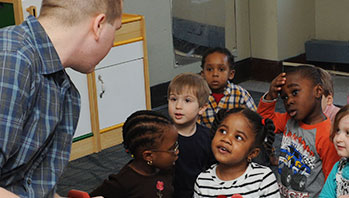- rubber bands of different thicknesses
- shoe boxes, bread pans, and other open containers around which the rubber bands can be stretched
- high
- low
- pluck
- sound
MA Standards:
Speaking and Listening: SL.PK.MA.1 Participate in collaborative conversations with diverse partners during daily routines and play.
Language: L.PK.MA.1 Demonstrate use of oral language in informal everyday activities.
Language: L.PK.MA.6 Use words and phrases acquired through conversations, listening to books read aloud, activities, and play.
Head Start Outcomes:
Language Development/Receptive Language Attends to language during conversations, songs, stories, or other learning experiences.
Language Development/Expressive Language Uses language to express ideas and needs.
PreK Learning Guidelines:
English Language Arts/Language 2 Participate actively in discussions, listen to the ideas of others, and ask and answer relevant questions.
Talk Together: More Rubber Band Music

© Commonwealth of Massachusetts, Department of Early Education and Care (Jennifer Waddell photographer). All rights reserved.
STEM Key Concepts: An action has to happen to make a sound; Sounds vary in three ways: volume (loud or soft), pitch (high or low), and timbre (quality)
ELA Focus Skills: Listening and Speaking; Vocabulary
Gather children around the materials. Pluck the rubber bands to make sounds. As you make sounds ask children,
- What kind of sound did I just make? How would you describe it? Encourage children to use new vocabulary such as high and low.
- What could I do to make a different sound? Guide children to recall how stretching the rubber bands tighter can change the sound. Have them describe the new sounds you make.
Invite children to pluck the rubber bands to make their own sounds. As they explore, ask them to recall some of the discoveries they made last week. You may want to play back some of the recordings from last week’s explorations to help children recall some of the sounds they made. Have them tell you something new they learned about sounds. Add new discoveries to the “What We Know About Sound” chart you began at the beginning of the unit.
